
Celestron's Ultima 9.25 inch SCT
Introduction
Having previously reviewed the Meade LX200 (10 inch), it was a pleasure to
try out Celestron's Ultima (9.25 inch), while it isn't a straight one to
one comparison as this Celestron isn't computerised, it does offer some features
that are well thought out and are of real benefit to the user. There is a
quality feel to the instrument that seemed to be lacking with the Meade,
this is apparent with the tightness of the drives, the way the tripod legs
are locked into position and yet only take a few moments to slacken for
transport, the superb multi-turn counter on the focus knob - really useful
for CCD work.
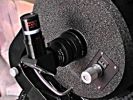 |
 |
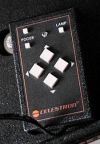 |
| fig 1 (23K jpg) |
fig 2 (16K jpg) |
fig 3 (20k jpg) |
Click on any picture on this page for an enlarged view - return by right
clicking the mouse
This instrument is at the upper limit of portability by one person, any larger
and it becomes a struggle, it is noticeably lighter and easier to set up
than the 10 inch Meade LX200 and can be transported in the back of a small
hatch back car.
The declination motor drive is a friction fit, I'm not sure about this, but
it seems tight and works well enough. The levers for slackening off the ra
and dec drives are well thought out.
 |
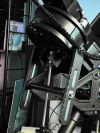 |
 |
| fig 4 (18K jpg) |
fig 5 (21K jpg) |
fig 6 (16k jpg) |
There are sockets for external 12 volt supply (hardly needed with the economical
battery useage), declination motor and remote focus, this remote focus doesn't
really seem necessary with the smooth multi-turn focus knob.
There are no digital setting circles supplied as standard, this is a basic
mechanical scope that relies on engraved circles which aren't any different
to those on most other SCT's, having said that, using a Telrad and star hopping
works well enough for most people. The excellent tracking and 'learning'
periodic error correction (PEC) makes for very easy photographic use.
Good Points
1. There was no noticeable backlash or play in either ra or dec.
2. There are 'hand wheel' bolts for fixing the fork assembly to the wedge,
you don't need Allen keys.
3. Runs for ages on an alkaline PP3 sized battery
4. Four different ra drive rates (see fig 2)
5. The tripod is easy to set up. Being almost as large as a 10 inch unit,
it is surprisingly light and easy to transport.
6. Optional 7 x 50 illuminated 'polar alignment' finder scope, engraved with
hourly marks to align on Polaris. This kind of polar alignment scope is not
sufficiently accurate compared to the Vixen and Losmandy polar axis type.
7. The digital turns counter on the focus knob is excellent and very accurate.
8. Superb optics, viewing Venus at high magnification, when the scope was
unpacked from a car only a few moments earlier, was incredible.
Bad Points
1. Only supplied with a 6 x 30 finder as standard, not good enough for a
scope of this calibre.
2. On this (12 month old) version you have to remove the ra drive's front
plate to change the battery, not only does this require a screwdriver, but
you can loose the screws and break wires off. I understand that units now
have a proper battery cover.
3. The fork assembly (to wedge) lower two mounting bolts don't line up when
the top bolt is in place (it fits into a slot and at this point the lower
bolts won't fit, you then have to raise it slightly to fit the lower bolts),
this can be overcome with a little modification and has already been modified
with later shipping units.
4. There is some darkening of the edges of star field photographs, even when
using the optional f6.3 focal reducer, this is probably common to most SCT's
and shouldn't cause too many problems.
5. There are no tools supplied.
6. In common with many fork mounted telescopes, there is no polar alignment
telescope. Accurate polar alignment is only possible by the drift method,
this can take an hour or more. By comparison, Vixen and Losmandy german
equatorial mounts can be fitted with very accurate polar alignment scopes
in their polar axis.
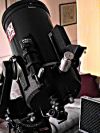 |
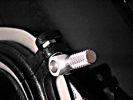 |
 |
| fig 7 (19K jpg) |
fig 8 (13K jpg) |
fig 9 (15k jpg) |
What else can I say, other than to consider the Losmandy German equatorial
version! A very well engineered instrument with most of the features that
really matter when viewing the sky or taking photographs
Special thanks to Jim Cormell for demonstrating his Celestron 9.25 inch scope.
Jump to top of page



|
